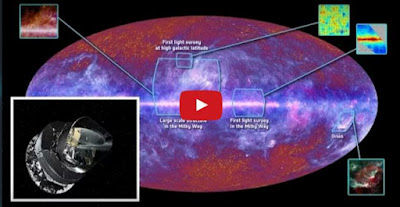A tantalising glimpse of a parallel universe bumping against our own has been spotted by astronomers. Scientists say they have seen hints in signals from the furthest reaches of space that suggest the fabric of our universe is being disrupted by another quite different universe.
A scientist form California Institute of Technology has discovered signs of a parallel universe using the ESA’s Planck Space Telescope.
The tentative conclusion of an analysis by Ranga-Ram Chary, a researcher at Planck’s US data center in California. Armed with Planck’s painstaking map of the cosmic microwave background (CMB) – light lingering from the hot, soupy state of the early universe.
The cosmic microwave background (pictured) is radiation left over from the early stages of the universe following the Big Bang. Astronomers have shown it has hot and cold spots according to the distribution of matter in the early universe. Dr Chary has found a hidden signal in this that may come from another universe
Chary revealed an eerie glow that could be due to matter from a neighbouring universe leaking into ours, reports New Scientist.
This sort of collision should be possible, according to modern cosmological theories that suggest the universe we see is just one bubble among many. Such a multiverse may be a consequence of cosmic inflation, the widely accepted idea that the early universe expanded exponentially in the slimmest fraction of a second after the big bang.
Once it starts, inflation never quite stops, so a multitude of universes becomes nearly inevitable.
“I would say most versions of inflation in fact lead to eternal inflation, producing a number of pocket universes,”says Alan Guth of the Massachusetts Institute of Technology, an architect of the theory.
The multiverse (or meta-universe) is the hypothetical set of infinite or finite possible universes (including the Universe we consistently experience) that together comprise everything that exists: the entirety of space, time, matter, and energy as well as the physical laws and constants that describe them.
The various universes within the multiverse are also called “parallel universes” or “alternate universes”.
The structure of the multiverse, the nature of each universe within it and the relationships among the various constituent universes, depend on the specific multiverse hypothesis considered. Multiple universes have been hypothesized in cosmology, physics, astronomy, religion, philosophy, transpersonal psychology, and fiction, particularly in science fiction and fantasy.
In these contexts, parallel universes are also called “alternate universes”, “quantum universes”, “interpenetrating dimensions”, “parallel dimensions”, “parallel worlds”, “alternate realities”, “alternate timelines”, and “dimensional planes”, among other names. The American philosopher and psychologist William James coined the term multiverse in 1895, but in a different context.














